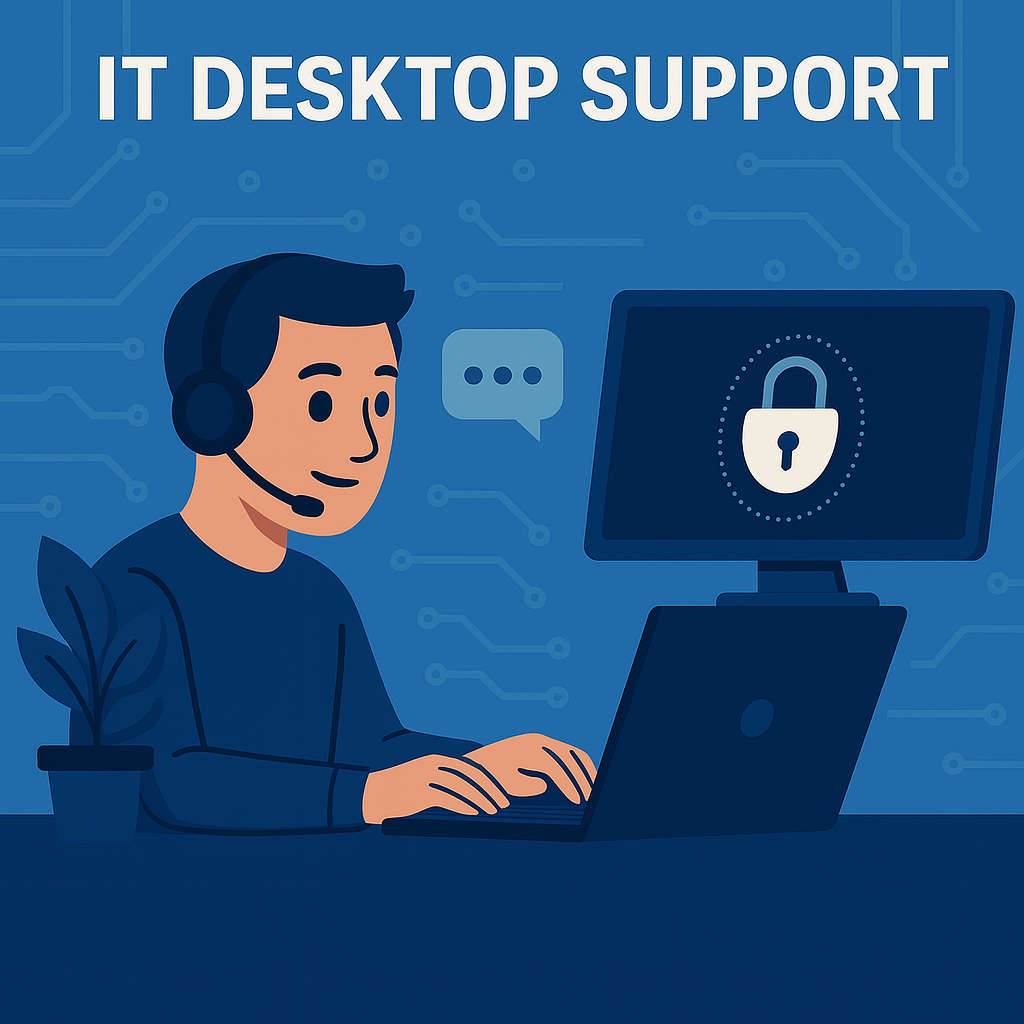Optimizing IT Operations Through Professional Desktop Support

A smooth and efficient IT infrastructure can mean the difference between success and chaos. As organizations rely more on technology, ensuring optimal performance of desktop systems becomes crucial. This is where desktop support services come into play, acting as the guardian of your organization’s IT operations.
In this guide, we’ll explore how professional desktop support optimizes IT operations, streamlines productivity, and ensures seamless business continuity. Whether you’re a business owner, IT manager, or simply looking to understand the importance of desktop support, this guide will provide a clear and easy-to-understand breakdown of all the essential aspects.
1. What is Desktop Support?
Desktop support refers to the technical assistance provided to end-users in an organization for their computing devices such as desktops, laptops, and related software. The goal is to resolve issues, enhance system performance, and maintain operational continuity.
Key Functions of Desktop Support:
- Troubleshooting and Resolving Issues: Addressing hardware and software problems, network connectivity, and application errors.
- Maintenance and Updates: Ensuring all devices are up-to-date with the latest security patches and software updates.
- User Assistance: Helping users with day-to-day tasks, like setting up new devices, troubleshooting errors, or guiding them through system features.
2. The Importance of Professional Desktop Support for IT Operations
In today’s fast-paced digital landscape, any downtime can lead to significant operational setbacks. Professional desktop support ensures that IT operations run smoothly by resolving issues quickly and efficiently.
Why It’s Essential:
- Minimizes Downtime: Professional desktop support services can quickly identify and fix issues, minimizing disruptions to workflows.
- Boosts Productivity: By ensuring that systems run efficiently, employees can focus on their tasks without technical delays.
- Security Assurance: IT desktop support teams ensure that your organization’s devices are secure, reducing the risk of data breaches or malware attacks.
3. Key Benefits of Optimizing IT Operations with Desktop Support
A. Enhanced System Performance
With regular maintenance, desktop support teams can detect and address issues before they escalate, ensuring optimal system performance.
B. Increased Operational Efficiency
Professional desktop support services contribute to smoother workflows by reducing technical bottlenecks, allowing employees to stay productive.
C. Cost Savings
By preventing hardware and software failures, desktop support teams help businesses avoid costly downtime and repairs.
D. Better Employee Experience
End-users benefit from faster resolutions and improved access to technical assistance, boosting overall satisfaction and productivity.
4. How Professional Desktop Support Enhances Security in IT Operations
One of the major roles of IT desktop support is to ensure the security of IT operations. In an era where cyber threats are rampant, security must be a top priority for any organization.
Key Security Features of Desktop Support:
- Regular System Updates: Ensuring all devices are patched with the latest security updates.
- Virus and Malware Protection: Installing and managing anti-virus software to prevent threats.
- Data Backup: Ensuring regular data backups to prevent data loss in case of system failures or cyberattacks.
5. Common Challenges in IT Operations and How Desktop Support Addresses Them
Running a successful IT operation comes with its own set of challenges, from network issues to software bugs. Professional desktop support services are trained to handle these problems efficiently.
Typical IT Challenges:
- Network Connectivity Issues: Desktop support technicians ensure uninterrupted network access, solving connectivity problems quickly.
- Software Compatibility Issues: Desktop support teams can ensure that all software functions well together, preventing compatibility issues.
- System Crashes: IT desktop support identifies the root causes of crashes and implements solutions to prevent them from recurring.
6. Proactive vs. Reactive Desktop Support
There are two approaches to desktop support: proactive and reactive. Understanding the difference is crucial to optimizing IT operations.
Proactive Support
This approach involves anticipating problems before they occur. Desktop support technicians monitor systems for potential issues and perform regular maintenance to prevent disruptions.
Reactive Support
This method addresses problems after they occur. While it’s essential to fix issues when they arise, reactive support can lead to unexpected downtime if not paired with a proactive strategy.
7. Outsourcing vs. In-House Desktop Support
When it comes to managing desktop support, businesses often face the decision of whether to outsource or keep the service in-house. There are advantages and disadvantages to both solutions.
Outsourcing Desktop Support:
- Pros: Access to a team of experts, reduced overhead costs, and scalability.
- Cons: Less direct control, potential delays in response time.
In-House Desktop Support:
- Pros: Full control, immediate access to IT staff, tailored to company needs.
- Cons: Higher costs, requires more resources and staffing.
8. Key Tools and Software for Desktop Support
Professional desktop support services rely on various tools to monitor and manage systems effectively. These tools help to streamline procedures and increase overall efficiency.
Essential Tools:
- Remote Desktop Software: Allows desktop support technicians to access devices remotely for troubleshooting.
- Monitoring Tools: Software that tracks system performance and security issues in real time.
- Ticketing Systems: Manages and prioritizes user requests for support.
9. How to Choose the Right Desktop Support Team
When choosing a desktop support team, whether in-house or outsourced, there are certain factors to consider to ensure your IT operations are well-optimized.
Considerations:
- Experience and Expertise: Look for a team with a proven track record in desktop support services.
- Response Time: Ensure the team can provide prompt responses to technical issues.
- Communication Skills: Effective communication is key in resolving IT problems quickly and efficiently.
10. Future Trends in Desktop Support and IT Operations
As technology evolves, so does the role of desktop support technicians. Staying ahead of these trends can help businesses stay competitive and optimize their IT operations.
Emerging Trends:
- Artificial Intelligence (AI): AI-powered tools will increasingly assist desktop support services in troubleshooting and resolving issues faster.
- Automation: Routine tasks such as software updates and backups can be automated, freeing up desktop support technicians to focus on more complex issues.
- Cloud Support: As more businesses shift to the cloud, IT desktop support teams will need to specialize in managing cloud-based systems and applications.
FAQs on Optimizing IT Operations Through Desktop Support
Q1: What’s the difference between help desk and desktop support?
While both are IT support services, help desk is more general, handling a range of user issues, while desktop support focuses specifically on resolving hardware and software problems with desktops, laptops, and related equipment.
Q2: Can small businesses benefit from professional desktop support services?
Absolutely! Small businesses can enhance their IT operations, reduce downtime, and improve security with the help of professional desktop support.
Q3: How often should desktops be updated?
Desktops should be updated regularly, typically once a month, to ensure they receive the latest security patches and performance improvements.
Q4: Is desktop support only for large corporations?
No, desktop support services are scalable and can be tailored to fit businesses of all sizes, from startups to large enterprises.
Q5: What’s the role of desktop support in disaster recovery?
Desktop support plays a critical role in disaster recovery by ensuring data is backed up and systems are restored quickly in the event of a disaster.
Q6: How can desktop support reduce IT costs?
By preventing major system failures and minimizing downtime, desktop support services help reduce the need for costly repairs and lost productivity.
Conclusion
Optimizing IT operations through professional desktop support is an essential strategy for any business relying on technology. It not only ensures smooth daily operations but also helps in maintaining security, boosting productivity, and reducing costs. Whether you’re a small business or a large corporation, investing in desktop support services will ensure your IT infrastructure remains robust and reliable.




No comment